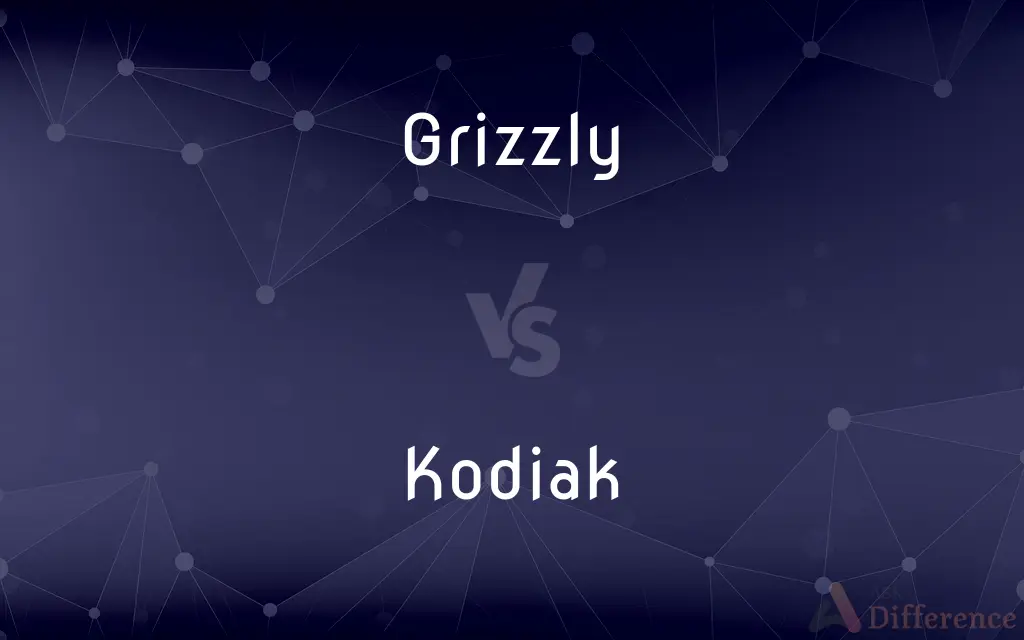Grizzly vs. Kodiak — What's the Difference?
By Urooj Arif & Maham Liaqat — Updated on March 24, 2024
Grizzly bears are known for their adaptability across various environments, whereas Kodiak bears, a subspecies, are specific to Alaska's Kodiak Archipelago.

Difference Between Grizzly and Kodiak
Table of Contents
ADVERTISEMENT
Key Differences
Grizzly bears, found across North America, are versatile in habitat, ranging from woodlands to mountains. They're distinguished by their physical adaptations like powerful forelimbs and humped shoulders, which aid in digging and foraging. Whereas Kodiak bears, isolated on the Kodiak Islands, have evolved to be among the largest bears due to rich salmon sources, showcasing nature's influence on size due to dietary availability.
Grizzlies exhibit a varied diet, including plants, mammals, and carrion, showcasing their adaptability. They're known to move across vast ranges in search of food, which shapes their behavior and interactions with the environment. On the other hand, Kodiak bears have a diet heavily reliant on fish, particularly salmon, which is abundant in their isolated habitat. This diet contributes to their massive size and relatively stable population.
Regarding behavior, Grizzly bears have a more aggressive reputation, partly due to their frequent interactions with humans, leading to a broader range of defensive behaviors. Whereas Kodiak bears, with less human interaction on the islands, tend to be less aggressive towards humans, reflecting the impact of human presence on wildlife behavior.
Conservation status reflects human impact and environmental challenges faced by these bears. Grizzly bears are considered more at risk due to habitat encroachment and historical overhunting, necessitating extensive conservation efforts across their range. Kodiak bears, however, benefit from the isolation of the Kodiak Archipelago, which has helped maintain a stable population, underlining the importance of protected areas for species conservation.
In social structure, grizzlies are solitary, coming together only during mating seasons or at abundant food sources like salmon runs. Kodiak bears, while also solitary, may gather in larger numbers due to the high density of food available in their limited geographic range, highlighting how food availability influences social behavior in bears.
ADVERTISEMENT
Comparison Chart
Habitat
Varied across North America
Kodiak Archipelago, Alaska
Size & Physical Characteristics
Large with distinctive hump on shoulders
Among the largest bears due to rich diet
Diet
Omnivorous: plants, mammals, carrion
Primarily salmon, with seasonal variations
Behavior
Can be aggressive, especially near humans
Less human interaction, generally less aggressive
Conservation Status
More at risk due to human activities
Stable population, benefited from isolation
Compare with Definitions
Grizzly
A large North American bear with a distinctive hump on its shoulders.
The grizzly bear roamed the forest, searching for berries.
Kodiak
A subspecies of brown bear native to Alaska's Kodiak Archipelago.
The Kodiak bear, one of the largest bears, is found only in Alaska.
Grizzly
Known for its strength and adaptability across various habitats.
The grizzly bear's ability to adapt is key to its survival.
Kodiak
Primarily feeds on salmon, affecting its size and health.
The Kodiak bear's diet is rich in salmon, especially during the salmon run.
Grizzly
They play a crucial role in the ecosystem as apex predators.
By controlling prey populations, the grizzly bear maintains ecological balance.
Kodiak
Exhibits less aggressive behavior than other bears.
Kodiak bears, accustomed to a less disturbed environment, show less aggression.
Grizzly
Grizzlies have a varied diet that includes both plants and animals.
The grizzly bear's omnivorous diet includes fruits, nuts, and small mammals.
Kodiak
Less interaction with humans compared to other bear species.
The isolated habitat of the Kodiak bear limits its encounters with humans.
Grizzly
Their interactions with humans can often lead to conflict.
Grizzly bear sightings near human settlements have increased, leading to concerns about safety.
Kodiak
Has a stable population due to its isolated environment.
Conservation efforts and isolation have helped maintain the Kodiak bear population.
Grizzly
Grayish or flecked with gray.
Kodiak
Same as Kodiak bear.
Grizzly
A grizzly bear.
Kodiak
An island off southern Alaska in the Gulf of Alaska; site of the first European settlement in the area which was founded by the Russians in 1784
Grizzly
Grey-haired, greyish.
Kodiak
Brown bear of coastal Alaska and British Columbia
Grizzly
A grizzly bear.
Shotgun blast kills charging grizzly!
Grizzly
In hydraulic mining, a grating used to catch and throw out large stones from the sluices.
Grizzly
Somewhat gray; grizzled.
Old squirrels that turn grizzly.
Grizzly
In hydraulic mining, gratings used to catch and throw out large stones from the sluices.
Grizzly
Powerful brownish-yellow bear of the uplands of western North America
Grizzly
Showing characteristics of age, especially having gray or white hair;
Whose beard with age is hoar
Nodded his hoary head
Common Curiosities
What is the diet of a grizzly bear?
Grizzly bears have an omnivorous diet that includes plants, mammals, and carrion.
Why are Kodiak bears isolated to the Kodiak Archipelago?
Kodiak bears are isolated due to the geographic separation of the Kodiak Archipelago, which has limited their spread to other regions.
Are Kodiak bears more aggressive than grizzly bears?
Kodiak bears tend to be less aggressive towards humans, mainly due to their isolated habitat and reduced human interaction.
What conservation status do grizzly bears have?
Grizzly bears are considered more at risk due to habitat encroachment and historical overhunting, necessitating conservation efforts.
How does human interaction compare between grizzly and Kodiak bears?
Grizzly bears have more frequent interactions with humans, leading to a broader range of defensive behaviors, while Kodiak bears, with less human interaction, tend to be less aggressive.
Can Kodiak bears be found outside of Alaska?
No, Kodiak bears are native and restricted to the Kodiak Archipelago in Alaska.
What distinguishes a grizzly bear from a Kodiak bear?
Grizzly bears are a subspecies of brown bear found across North America with a distinct shoulder hump, whereas Kodiak bears are a subspecies isolated to Alaska's Kodiak Archipelago, known for their large size due to a diet rich in salmon.
How does the Kodiak bear's diet affect its size?
The Kodiak bear's diet is heavily reliant on salmon, which contributes to its massive size and overall health.
What roles do grizzly bears play in their ecosystems?
As apex predators, grizzly bears play a crucial role in maintaining ecological balance by controlling prey populations.
Where do Kodiak bears live?
Kodiak bears live exclusively on the islands of the Kodiak Archipelago in Alaska.
How does the physical appearance of grizzly bears differ from Kodiak bears?
Grizzly bears have a distinct hump on their shoulders and are generally smaller than Kodiak bears, which are among the largest bears.
How do Kodiak and grizzly bears differ in social behavior?
Both are solitary, but Kodiak bears may gather in larger numbers during abundant food sources, unlike grizzlies which are more solitary due to their wider habitat range.
What are the main threats to grizzly bear populations?
Main threats include habitat loss, climate change, and human conflict.
What efforts are being made to conserve grizzly bears?
Conservation efforts for grizzly bears include habitat protection, legal protections, and initiatives to reduce human-bear conflicts.
How has the Kodiak bear's diet enabled it to become one of the largest bear species?
The rich, salmon-based diet of the Kodiak bear provides high nutritional value, which supports their large size and health.
Share Your Discovery

Previous Comparison
Subway vs. Underground
Next Comparison
Protestant vs. BaptistAuthor Spotlight
Written by
Urooj ArifUrooj is a skilled content writer at Ask Difference, known for her exceptional ability to simplify complex topics into engaging and informative content. With a passion for research and a flair for clear, concise writing, she consistently delivers articles that resonate with our diverse audience.
Co-written by
Maham Liaqat















































